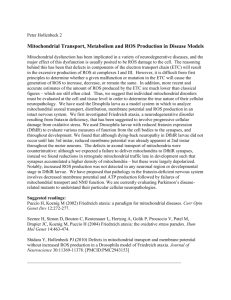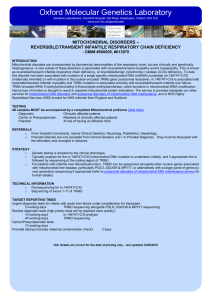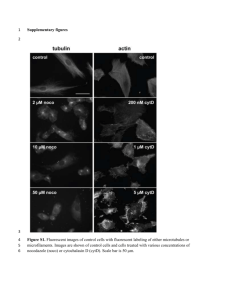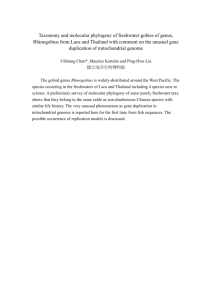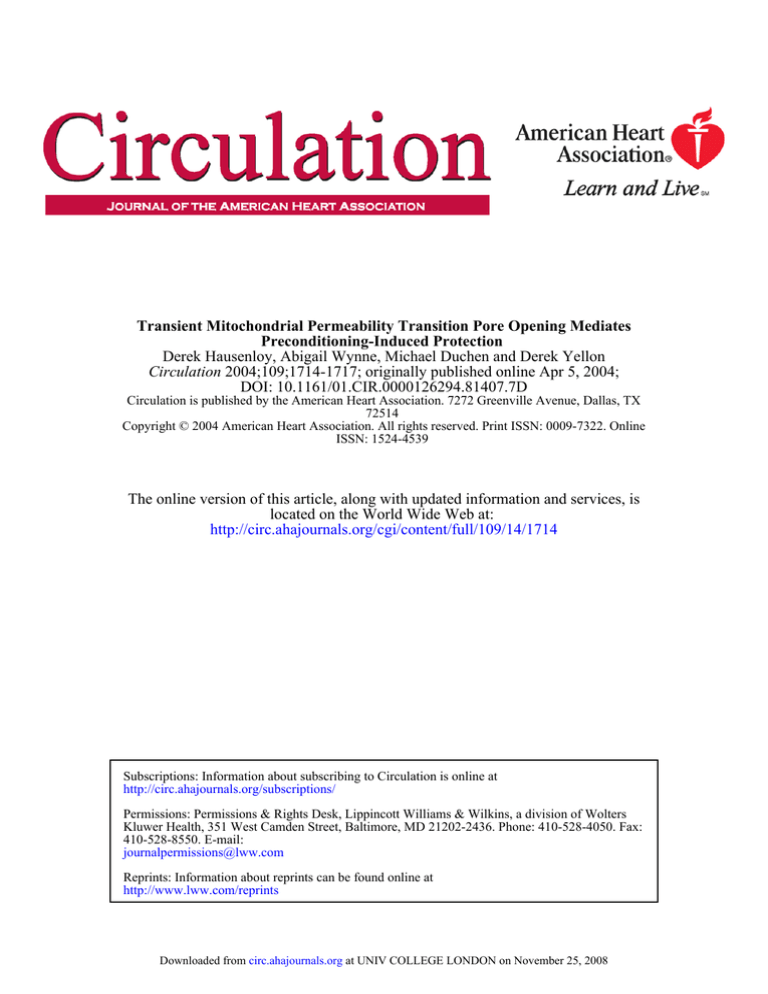
Transient Mitochondrial Permeability Transition Pore Opening Mediates
Preconditioning-Induced Protection
Derek Hausenloy, Abigail Wynne, Michael Duchen and Derek Yellon
Circulation 2004;109;1714-1717; originally published online Apr 5, 2004;
DOI: 10.1161/01.CIR.0000126294.81407.7D
Circulation is published by the American Heart Association. 7272 Greenville Avenue, Dallas, TX
72514
Copyright © 2004 American Heart Association. All rights reserved. Print ISSN: 0009-7322. Online
ISSN: 1524-4539
The online version of this article, along with updated information and services, is
located on the World Wide Web at:
http://circ.ahajournals.org/cgi/content/full/109/14/1714
Subscriptions: Information about subscribing to Circulation is online at
http://circ.ahajournals.org/subscriptions/
Permissions: Permissions & Rights Desk, Lippincott Williams & Wilkins, a division of Wolters
Kluwer Health, 351 West Camden Street, Baltimore, MD 21202-2436. Phone: 410-528-4050. Fax:
410-528-8550. E-mail:
journalpermissions@lww.com
Reprints: Information about reprints can be found online at
http://www.lww.com/reprints
Downloaded from circ.ahajournals.org at UNIV COLLEGE LONDON on November 25, 2008
Transient Mitochondrial Permeability Transition Pore
Opening Mediates Preconditioning-Induced Protection
Derek Hausenloy, MBChB; Abigail Wynne, BSc; Michael Duchen, PhD; Derek Yellon, DSc
Background—Transient (low-conductance) opening of the mitochondrial permeability transition pore (mPTP) may limit mitochondrial calcium load and mediate mitochondrial reactive oxygen species (ROS) signaling. We hypothesize that transient mPTP opening
and ROS mediate the protection associated with myocardial preconditioning and mitochondrial uncoupling.
Methods and Results—Isolated perfused rat hearts were subjected to 35 minutes of ischemia/120 minutes of reperfusion,
and the infarct-risk-volume ratio was determined by tetrazolium staining. Inhibiting mPTP opening during the
preconditioning phase with cyclosporine-A (CsA, 0.2 mol/L) or sanglifehrin-A (SfA, 1.0 mol/L) abolished the
protection associated with ischemic preconditioning (IPC) (20.2⫾3.6% versus 45.9⫾2.5% with CsA, 49.0⫾7.1% with
SfA; P⬍0.001); and pharmacological preconditioning with diazoxide (Dzx, 30 mol/L) (22.1⫾2.7% versus 46.3⫾3.0%
with CsA, 48.4⫾5.5% with SfA; P⬍0.001), CCPA (the adenosine A1-receptor agonist, 200 nmol/L) (24.9⫾4.5% versus
54.4⫾6.6% with CsA, 42.6⫾9.0% with SfA; P⬍0.001), or 2,4-dinitrophenol (DNP, the mitochondrial uncoupler, 50
mol/L) (15.7⫾2.7% versus 40.8⫾5.5% with CsA, 34.3⫾3.1% with SfA; P⬍0.001), suggesting that mPTP opening
during the preconditioning phase is required to mediate protection in these settings. Inhibiting ROS during the
preconditioning protocols with N-mercaptopropionylglycine (MPG, 1 mmol/L) also abolished the protection associated
with IPC (20.2⫾3.6% versus 47.1⫾3.8% with MPG; P⬍0.001), diazoxide (22.1⫾2.7% versus 56.3⫾3.8% with MPG;
P⬍0.001), and DNP (15.7⫾2.7% versus 50.7⫾6.6% with MPG; P⬍0.001) but not CCPA (24.9⫾4.5% versus
26.5⫾8.4% with MPG; P⫽NS). Further experiments in adult rat myocytes demonstrated that diazoxide induced
CsA-sensitive, low-conductance transient mPTP opening (represented by a 28⫾3% reduction in mitochondrial calcein
fluorescence compared with control; P⬍0.01).
Conclusions—We report that the protection associated with IPC, diazoxide, and mitochondrial uncoupling requires
transient mPTP opening and ROS. (Circulation. 2004;109:1714-1717.)
Key Words: ischemia 䡲 myocardial infarction 䡲 free radicals 䡲 reperfusion
D
espite ongoing intensive investigation, the actual mechanism responsible for the powerful protective phenomenon that is ischemic preconditioning (IPC)1 has not yet been
elucidated. Studies have implicated mitochondria in protective mechanisms associated with IPC. Pharmacological opening of the purported mitochondrial KATP channel2 has been
demonstrated to cardioprotect by preserving mitochondrial
energy production during ischemia-reperfusion.3 We and
others have implicated modest mitochondrial uncoupling as a
critical event in preconditioning-induced protection.4,5 Mitochondrial reactive oxygen species (ROS) release may mediate
the preconditioning signal.6 We have demonstrated that the
prolonged (high-conductance) mitochondrial permeability
transition pore (mPTP) opening, which mediates cell death at
the time of reperfusion, can be inhibited by preconditioning.7
The present study focuses on the physiological transient
(low-conductance) form of mPTP opening, which does not lead
to cell death8 and in fact may play several important functions
that may contribute to IPC-induced protection. Transient (lowconductance) mPTP opening (1) can limit mitochondrial matrix
calcium load by mediating mitochondrial calcium efflux9; (2)
can be induced by mitochondrial uncoupling10; and (3) can
mediate mitochondrial ROS release.11
This would suggest that low-conductance transient mPTP
opening may contribute to the mechanism of IPC-induced
protection. In this regard, the preconditioning mimetic diazoxide has been demonstrated to induce mPTP opening.12 On
this basis, we hypothesized that both transient (lowconductance) mPTP opening and ROS, during the preconditioning phase, mediate both preconditioning and mitochondrial uncoupling–induced protection.
Methods
Isolated Perfused Rat Heart
Hearts excised from male Sprague-Dawley rats were Langendorffperfused with Krebs-Henseleit buffer and subjected to 35 minutes of
Received November 19, 2003; revision received February 18, 2004; accepted February 24, 2004.
From the Mitochondrial Biology Group, Department of Physiology, University College London, UK (M.D.); and The Hatter Institute and Centre for
Cardiology, University College London, UK (D.H., A.W., D.Y.).
Correspondence to Prof Derek Yellon, The Hatter Institute and Centre for Cardiology, University College London, Grafton Way, WC1E 6DB, UK.
E-mail hatter-institute@ucl.ac.uk
© 2004 American Heart Association, Inc.
Circulation is available at http://www.circulationaha.org
DOI: 10.1161/01.CIR.0000126294.81407.7D
1714
Downloaded from circ.ahajournals.org at UNIV
COLLEGE LONDON on November 25, 2008
Hausenloy et al
Preconditioning and Mitochondrial Permeability
1715
Figure 1. A, Inhibiting mPTP opening
with either CsA or SfA or scavenging
ROS by using MPG during preconditioning phase abolishes protection associated with IPC and Dzx. B, Inhibiting
mPTP opening with either CsA or SfA
during preconditioning phase abolishes
protection associated with CCPA and
DNP. Scavenging ROS during preconditioning phase by using MPG abolishes
protection associated with DNP but not
CCPA (*P⬍0.05).
ischemia followed by 120 minutes of reperfusion, and the infarctrisk-volume ratio was determined by triphenyltetrazolium-chloride
staining.7
diazoxide (n⫽18/group;30 mol/L) in the presence or absence of
CsA (0.2 mol/L) or 5-HD (100 mol/L).2
Statistical Analysis
Treatment Protocols for Infarct Studies
The hearts were treated as follows (nⱖ6/group):
(1) Control hearts were perfused with 0.02% DMSO or 0.005%
ethanol, or Krebs-Henseleit buffer alone during stabilization.
(2) IPC hearts were treated with two 5-minute periods of global
ischemia with a 10-minute intervening reperfusion.
(3, 4) Hearts underwent the IPC protocol in the presence of the
mPTP inhibitors cyclosporine-A (CsA 0.2 mol/L, Sigma)7 or
sanglifehrin-A (SfA 1.0 mol/L, Novartis).13
(5) Hearts underwent IPC in the presence of N-mercaptopropionylglycine
(MPG, the ROS scavenger, 1 mmol/L).14
(6, 7) Hearts were perfused with diazoxide (Dzx, 30 mol/L)2 for 10
minutes or the adenosine A1-receptor agonist CCPA (200 nmol/
L)7 for 10 minutes (during which the hearts were paced at 300
bpm for CCPA-induced bradycardia) followed by 10 minutes of
washout.
(8 –13) Hearts were preconditioned with diazoxide or CCPA in the
presence of CsA/SfA/MPG.
(14) Hearts were perfused with 2,4-dinitrophenol (DNP, a mitochondrial uncoupler, 50 mol/L)4 for 5 minutes followed by 10
minutes of washout.
(15–17) Hearts were perfused with DNP in the presence of
CsA/SfA/MPG.
(17–19) Hearts were perfused with CsA/SfA/MPG during
stabilization.
Model for Detecting mPTP Opening in Intact Cells
We used an established method for detecting transient (lowconductance) mPTP opening in the intact cell.12,15 Adult rat myocytes isolated by collagenase perfusion from Sprague-Dawley rats,
with the use of a previously described method,16 were incubated with
calcein-AM (1.0 mol/L) and cobalt-chloride (CoCl2, 1.0 mmol/L),
resulting in mitochondrial localization of calcein fluorescence.
mPTP opening was indicated by a reduction in mitochondrial calcein
signal (expressed as the percentage of the baseline value) and was
measured over 6 randomly chosen areas in 3 different cells every 5
minutes for 25 minutes, with the use of a Zeiss-510 CLSM confocal
microscope (emitting at 488 nm and detecting at 505 nm).
Cells were incubated for 20 minutes at 37°C with (1) 0.05%
ethanol vehicle (n⫽6); (2) 0.1% DMSO vehicle (n⫽6); or (3)
All values are expressed as mean⫾SEM. Infarct-risk-volume ratios
and mitochondrial calcein fluorescence intensities were analyzed by
1e-way ANOVA and Fisher’s protected least significant difference
test for multiple comparisons. Differences were considered significant at a value of P⬍0.05.
Results
Opening of the mPTP Is Required for Protection
Ischemic preconditioning, diazoxide, CCPA, or DNP reduced
infarct size from 49.9⫾3.8% in control to 20.2⫾3.6% with
IPC, 22.1⫾2.7% with diazoxide, 24.9⫾4.5% with CCPA,
and 15.7⫾2.7% with DNP (P⬍0.001; Figure 1A). Inhibiting
mPTP opening during the preconditioning protocol, with the
use of CsA/SfA, abolished the protection associated with IPC
(20.2⫾3.6% versus 45.9⫾2.5% with CsA, 49.0⫾7.1% with
SfA; P⬍0.001; Figure 1A), diazoxide (22.1⫾2.7% versus
46.3⫾3.0% with CsA, 48.4⫾5.5% with SfA; P⬍0.001;
Figure 1A), CCPA (24.9⫾4.5% versus 54.4⫾6.6% with CsA,
42.6⫾9.0% with SfA; P⬍0.001; Figure 1B), and DNP
(15.7⫾2.7% versus 40.8⫾5.5% with CsA, 34.3⫾3.1% with
SfA; P⬍0.001; Figure 1B), suggesting that mPTP opening is
required to mediate the protection in these settings. Given
alone, neither cyclosporine-A nor sanglifehrin-A influenced
infarct size (43.9⫾1.4% in control versus 42.8⫾3.5% with
CsA, 48.0⫾4.2% with SfA; P⫽NS; Figure 1B).
Reactive Oxygen Species Are Required
for Protection
The presence of the ROS scavenger MPG during the preconditioning protocols abolished the protection associated with
IPC (20.2⫾3.6% versus 47.1⫾3.8% with MPG; P⬍0.001;
Figure 1A), diazoxide (22.1⫾2.7% versus 56.3⫾3.8% with
MPG; P⬍0.001; Figure 1A), and DNP (15.7⫾2.7% versus
50.7⫾6.6% with MPG; P⬍0.001; Figure 1B), implicating
ROS as a mediator of protection in these settings. However,
Downloaded from circ.ahajournals.org at UNIV COLLEGE LONDON on November 25, 2008
1716
Circulation
April 13, 2004
Discussion
Figure 2. Mitochondrial calcein fluorescence (expressed as percentage of baseline fluorescence) in myocytes loaded with calcein and cobalt chloride demonstrate Dzx-induced reduction in
mitochondrial calcein fluorescence, indicating transient (lowconductance) mPTP opening, which is abolished in the presence of either 5-HD (a mitochondrial KATP channel blocker) or
CsA (an mPTP inhibitor) (*P⬍0.05).
MPG did not abolish the protection associated with CCPA
(24.9⫾4.5% versus 26.5⫾8.4% with MPG; P⬍0.001; Figure
1B). MPG alone did not influence infarct size (43.9⫾1.4% in
control versus 47.8⫾6.4% with MPG; P⫽NS; Figure 1B).
Diazoxide Induces Low-Conductance Transient
mPTP Opening
Treatment of calcein-loaded myocytes with diazoxide resulted in a reduction in mitochondrial calcein fluorescence to
72⫾3% of baseline values (P⬍0.01; Figure 2), indicating that
diazoxide induces low-conductance transient mPTP opening
in quiescent cells. This effect of diazoxide was abolished by
cyclosporine-A (the mPTP inhibitor, confirming that the
reduction in mitochondrial calcein fluorescence was due to
mPTP opening) and by 5-HD (the mitochondrial KATP channel
blocker) (Figure 2).
We report that transient (low-conductance) mPTP opening
and ROS, during the preconditioning phase, are required to
mediate the protection associated with ischemic and pharmacological preconditioning and mitochondrial -uncoupling. In
the infarct studies, we demonstrated that pharmacologically
inhibiting mPTP opening during the preconditioning phase
completely abrogated the protection associated with IPC,
diazoxide, and CCPA, indicating that mPTP opening is
required for protection in these settings. In the myocyte
model of mPTP opening,12,15 we demonstrated that diazoxide
induces transient (low-conductance) mPTP opening, confirming the findings of previous studies.12,17 We confirm that IPC
and diazoxide-induced protection is ROS-dependent and
found that CCPA-induced preconditioning is ROSindependent, supporting the findings of Cohen and
colleagues.6
We have previously demonstrated that modest mitochondrial uncoupling is a critical event in preconditioning-induced
protection.4,5 In the present study, we show that this protection can be abolished by inhibiting mPTP opening, suggesting
that mPTP opening occurs downstream of mitochondrial
uncoupling, which is supported by the fact that mitochondrial
uncoupling can induce mPTP opening.10 Transient mPTP
opening can induce mitochondrial ROS release,11 which may
explain why we found mitochondrial uncoupling–induced
protection to be ROS-dependent.
Transient mPTP opening during the preconditioning phase
may mediate protection by (Figure 3) reducing mitochondrial
calcium load9: In this regard, diazoxide has been shown to
induce mitochondrial calcium efflux through mPTP opening.12 Transient mPTP opening during the preconditioning
phase also may mediate protection by mediating mitochondrial ROS release/signaling11: We are undertaking further
studies to determine whether preconditioning-induced mitochondrial ROS release occurs through mPTP opening.
Because transient mPTP opening can be induced by uncoupling, oxidation of NADH,10 and an alkaline pH,8 the
Figure 3. Hypothetical scheme outlining
role for transient (low-conductance)
mPTP opening in myocardial preconditioning. mPTP comprises the voltagedependent anion channel (VDAC), adenine nucleotide translocase (ANT), and
cyclophilin D. Preconditioning induces
transient mPTP (low-conductance) opening through mitochondrial uncoupling,
ROS, and increasing matrix pH, which
then protects the heart by reducing mitochondrial calcium load and facilitating
ROS signaling.
Downloaded from circ.ahajournals.org at UNIV COLLEGE LONDON on November 25, 2008
Hausenloy et al
preconditioning stimulus may induce transient mPTP opening
by mediating uncoupling, producing mitochondrial ROS,
which then oxidize NADH,10 or by increasing matrix pH
through activation of the mitochondrial KATP channel.18
In conclusion, we report for the first time that IPC,
diazoxide, CCPA, and mitochondrial uncoupling all protect
by inducing transient mPTP opening during the preconditioning phase. Given that the adenine nucleotide translocase
(ANT) is believed to be a component of the mPTP8 and the
recent suggestion that the ANT forms part of the mitochondrial KATP channel,19 it would be intriguing to speculate on
whether agents that reportedly protect through opening of the
mitochondrial KATP channel actually protect through transient
(low-conductance) opening of the mPTP.
Acknowledgments
Dr Derek Hausenloy is supported by the British Heart Foundation.
We thank the Wellcome Trust for funding the confocal microscope.
References
1. Murry CE, Jennings RB, Reimer KA. Preconditioning with ischemia: a
delay of lethal cell injury in ischemic myocardium. Circulation. 1986;
74:1124 –1136.
2. Garlid KD, Paucek P, Yarov-Yarovoy V, et al. Cardioprotective effect of
diazoxide and its interaction with mitochondrial ATP-sensitive K⫹
channels: possible mechanism of cardioprotection. Circ Res. 1997;81:
1072–1082.
3. Dos Santos P, Kowaltowski AJ, Laclau MN, et al. Mechanisms by
which opening the mitochondrial ATP-sensitive K(⫹) channel
protects the ischemic heart. Am J Physiol Heart Circ Physiol. 2002;
283:H284 –H295.
4. Minners J, van den Bos EJ, Yellon DM, et al. Dinitrophenol, cyclosporin
A, and trimetazidine modulate preconditioning in the isolated rat heart:
support for a mitochondrial role in cardioprotection. Cardiovasc Res.
2000;47:68 –73.
5. Minners J, Lacerda L, McCarthy J, et al. Ischemic and pharmacological
preconditioning in Girardi cells and C2C12 myotubes induce mitochondrial uncoupling. Circ Res. 2001;89:787–792.
Preconditioning and Mitochondrial Permeability
1717
6. Cohen MV, Yang XM, Liu GS, et al. Acetylcholine, bradykinin, opioids,
and phenylephrine, but not adenosine, trigger preconditioning by generating free radicals and opening mitochondrial K(ATP) channels. Circ
Res. 2001;89:273–278.
7. Hausenloy DJ, Maddock HL, Baxter GF, et al. Inhibiting mitochondrial
permeability transition pore opening: a new paradigm for myocardial
preconditioning? Cardiovasc Res. 2002;55:534 –543.
8. Zoratti M, Szabo I. The mitochondrial permeability transition. Biochim
Biophys Acta. 1995;1241:139 –176.
9. Ichas F, Jouaville LS, Mazat JP. Mitochondria are excitable organelles
capable of generating and conveying electrical and calcium signals. Cell.
1997;89:1145–1153.
10. Zago EB, Castilho RF, Vercesi AE. The redox state of endogenous
pyridine nucleotides can determine both the degree of mitochondrial
oxidative stress and the solute selectivity of the permeability transition
pore. FEBS Lett. 2000;478:29 –33.
11. Zorov DB, Filburn CR, Klotz LO, et al. Reactive oxygen species (ROS)induced ROS release: a new phenomenon accompanying induction of the
mitochondrial permeability transition in cardiac myocytes. J Exp Med.
2000;192:1001–1014.
12. Katoh H, Nishigaki N, Hayashi H. Diazoxide opens the mitochondrial
permeability transition pore and alters Ca2⫹ transients in rat ventricular
myocytes. Circulation. 2002;105:2666 –2671.
13. Clarke SJ, McStay GP, Halestrap AP. Sanglifehrin A acts as a potent
inhibitor of the mitochondrial permeability transition and reperfusion
injury of the heart by binding to cyclophilin-D at a different site from
cyclosporin A. J Biol Chem. 2002;277:34793–34799.
14. Yue Y, Qin Q, Cohen MV, et al. The relative order of mK(ATP) channels,
free radicals and p38 MAPK in preconditioning’s protective pathway in
rat heart. Cardiovasc Res. 2002;55:681– 689.
15. Petronilli V, Miotto G, Canton M, et al. Transient and long-lasting
openings of the mitochondrial permeability transition pore can be monitored directly in intact cells by changes in mitochondrial calcein fluorescence. Biophys J. 1999;76:725–734.
16. Maddock HL, Mocanu MM, Yellon DM. Adenosine A(3) receptor activation protects the myocardium from reperfusion/reoxygenation injury.
Am J Physiol Heart Circ Physiol. 2002;283:H1307–H1313.
17. Holmuhamedov EL, Wang L, Terzic A. ATP-sensitive K⫹ channel
openers prevent Ca2⫹ overload in rat cardiac mitochondria. J Physiol.
1999;519 Pt 2:347–360.
18. Garlid KD, Paucek P. Mitochondrial potassium transport: the K(⫹) cycle.
Biochim Biophys Acta. 2003;1606:23– 41.
19. Ardehali H, Chen Z, Ko Y, et al. Multiprotein complex containing
succinate dehydrogenase confers mitochondrial ATP-sensitive K⫹
channel activity. Circulation. 2003;108(suppl I):I-1004.
Downloaded from circ.ahajournals.org at UNIV COLLEGE LONDON on November 25, 2008




